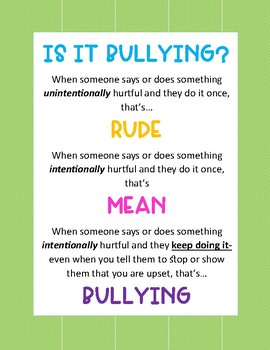Rude, Mean, or Bullying: How to Distinguish Behaviors
-
Bullying happens. It happens to our kids, it happens to adults. It’s not okay. When the term “bullying,” however, is used to describe every situation in which someone says or does something that hurts another person’s feelings, it minimizes the seriousness of real bullying.
 as well as the experiences of people who really are the victims of bullying. Overuse of this term is damaging and distracting the issue at hand as well as the legitimacy of true bullying. Parents and students utter this term and school staff, parents, friends, community - we all spring into action to investigate and call it out. This response has taught our children they can utilize this term when the attention is on them for a wrongdoing. They have learned they can instantly control any situation and shift the focus of their parents and teachers if they claim they are being bullied.
as well as the experiences of people who really are the victims of bullying. Overuse of this term is damaging and distracting the issue at hand as well as the legitimacy of true bullying. Parents and students utter this term and school staff, parents, friends, community - we all spring into action to investigate and call it out. This response has taught our children they can utilize this term when the attention is on them for a wrongdoing. They have learned they can instantly control any situation and shift the focus of their parents and teachers if they claim they are being bullied. It is imperative that all who care for our children at Brier Creek understand the distinctions between the terms rude, mean, and bullying. It is equally important that students learn how to identify and work through conflict. We use the following definitions to distinguish between these issues:
Rude: When someone unintentionally says or does something that is hurtful and is not repeated
Mean: When someone intentionally says or does something hurtful and is not repeated
Bullying: When someone repeatedly says or does things intentionally, despite being told to stop or the other person showing they are upset, and/or with an imbalance of power (or threat of power).
In addition to the resources linked at the bottom of this page, this video from the organization Sticks'N Stones may help with differentiating these three terms:
Conflict is another area that we must also distinguish. Pacer's National Bullying Prevention Center offers parents this guidance:
Bullying is Different from Conflict
Conflict is a disagreement or argument in which both sides share their views.
Bullying is done with a goal to hurt, harm, or humiliate.
Bullying behavior is often about having power and control over another person. In bullying, there is often a power imbalance between those involved, with power defined as elevated social status, being physically larger, or a group against an individual. Students who bully perceive their target as vulnerable in some way, and often find satisfaction in harming them.
In a normal conflict, children self-monitor their behavior. They read cues to know if lines are crossed, and then modify their behavior in response. Children guided by empathy usually realize they have hurt someone and will want to stop their negative behavior. On the other hand, children intending to cause harm and whose behavior goes beyond normal conflict will continue their behavior even when they know it's hurting someone.
For more information, read responses to the Question Answered: Conflict vs. Bullying: What's the Difference?
Conflict Resolution
The difference between bullying and conflict is important to note, because conflict resolution or mediation strategies are sometimes misused to solve bullying problems. These strategies can send the message that both children are “partly right and partly wrong,” or that, “We need to work out the conflict between you two.” These messages are not appropriate in cases of bullying (or in any situation where someone is being victimized). The appropriate message to the child who is being bullied should be, “Bullying is wrong and no one deserves to be bullied. We are going to do everything we can to stop it.”
Resources
Is it Rude, Is it Mean or Is it Bullying by Signe Whitson, Author and National Educator on bullying prevention, crisis intervention, and child and adolescent emotional and behavioral health.
Is it Rude, Is it Mean or Is it Bullying by Signe Whitson, Published in Psychology Today as a follow-up to her first article.
Is it Rude, Is it Mean or Is it Bullying - a presentation by Signe Whitson presented by the American School Counselor Association
Rude, Mean, or Bullying? A Child Therapist Defines the Differences on the website A Mighty Girl
Is it Rude, is it Mean, is it Bullying from the Blog Exploring School Counseling | includes printables and resources to use with kids


